“LA’s ZEV industry is ripe to accelerate even further because of the new administration nationally and also our governor and state budget, priorities and policies. We want to drive and support good paying jobs in the ZEV industry and also build out the infrastructure to increase adoption,” said LAEDC’s Judy Kruger to kickoff the January 22nd meeting of the e4 Mobility Alliance, LAEDC’s industry council focused on growing LA’s advanced transportation industry and its jobs.
This meeting on Zero Emission Vehicles (ZEVs) was the third in a series of policy discussions sponsored by Southern California Edison, to bring together legislators, industry leaders and other stakeholders to champion policy paths towards increased growth and hiring in this large and competitive LA industry sector (EV industry employs over 100K in SoCal: read the LAEDC EV report)
Note: Please bear with the paraphrasing in this summary article, and rely on the recorded video for exact statements from the speakers.
LAEDC industry councils include the SoCal Aerospace Council, the e4 Mobility Alliance for our advanced transportation industry cluster, the Bioscience Council and Digital Media & Entertainment (DME) Council. LAEDC convenes industry leaders to hear what they need, and uses those ideas to advance programs and policies to increase growth and hiring here in LA.
Watch the full 70-minute meeting
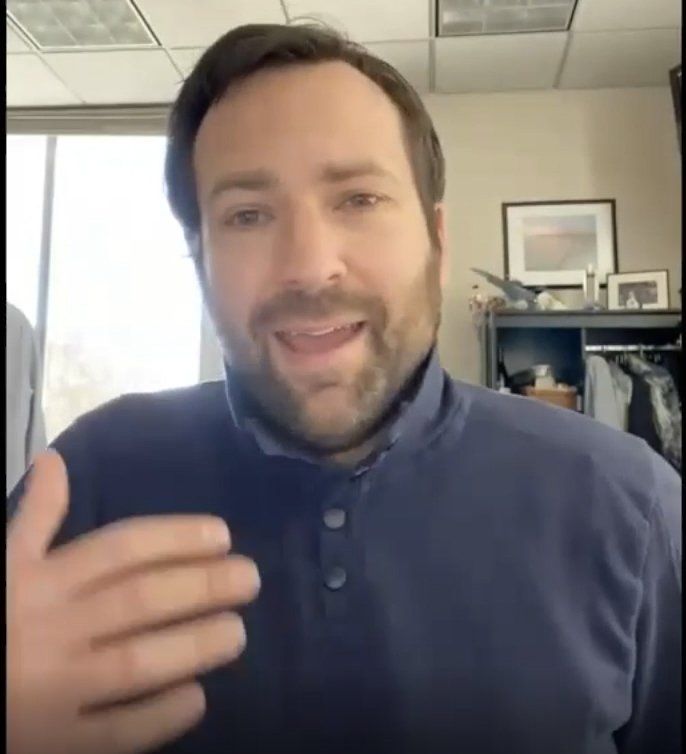 Senator Ben Allen presented his taped remarks for the meeting, and talked about this fascinating time and renewed partnerships for EVs in California. He said we have seen in California the impacts of climate crisis. We are a victim of, but a proactive participant in addressing that. Governor Newsom’s order to eliminate sales of ICE vehicles by 2035 will reduce greenhouse gases by 35%, and NOX emissions by 80% in the transportation sector. Medium and heavy-duty truck operations will need to be ZEVs where feasibly by 2045. The real question is how do we get there, to achieve these 2035/2045 goals? He said that the solution would include transit funding, electric buses, passenger ZEV vehicles, democratizing the world of EVs and making sure these technologies are more accessible to a broader percentage of our residents, through price reduction and charger access for those living in multifamily buildings. The scale of the challenge is significant, he said and reiterated that we will make it more accessible to more people. Senator Allen is also also pushing for expedited CEQA review for mass transit/green transit projects via bill SB44 (Allen) which would allow some of those projects to proceed more quickly.
Senator Ben Allen presented his taped remarks for the meeting, and talked about this fascinating time and renewed partnerships for EVs in California. He said we have seen in California the impacts of climate crisis. We are a victim of, but a proactive participant in addressing that. Governor Newsom’s order to eliminate sales of ICE vehicles by 2035 will reduce greenhouse gases by 35%, and NOX emissions by 80% in the transportation sector. Medium and heavy-duty truck operations will need to be ZEVs where feasibly by 2045. The real question is how do we get there, to achieve these 2035/2045 goals? He said that the solution would include transit funding, electric buses, passenger ZEV vehicles, democratizing the world of EVs and making sure these technologies are more accessible to a broader percentage of our residents, through price reduction and charger access for those living in multifamily buildings. The scale of the challenge is significant, he said and reiterated that we will make it more accessible to more people. Senator Allen is also also pushing for expedited CEQA review for mass transit/green transit projects via bill SB44 (Allen) which would allow some of those projects to proceed more quickly.
He closed by saying that this is our shared responsibility. “I have a baby myself and this is really personal for me. What kind of earth will his generation inherit?” California will continue to play a global leadership role. “Please reach out to my office,” including through Judy Kruger to engage with us.
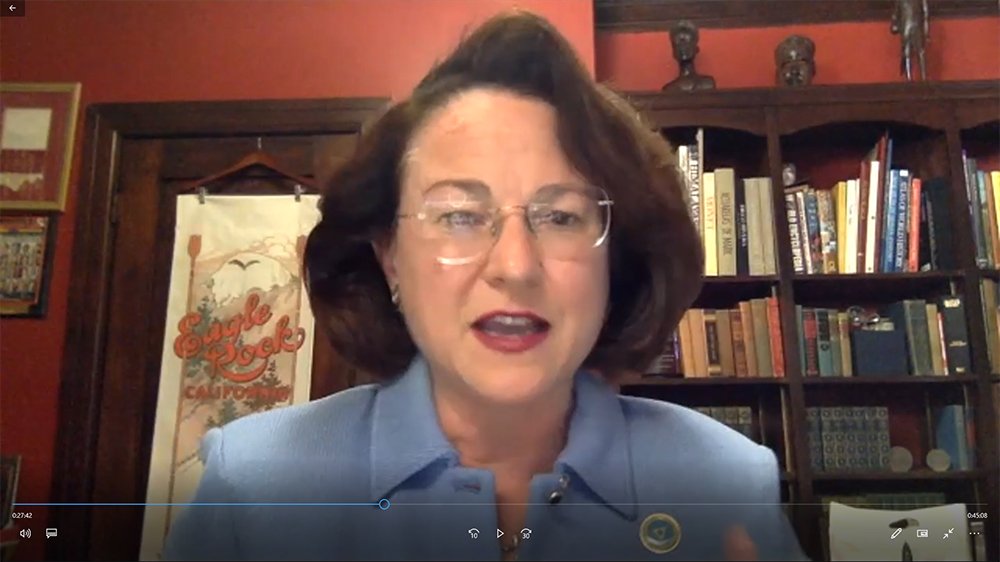
Hilary Norton
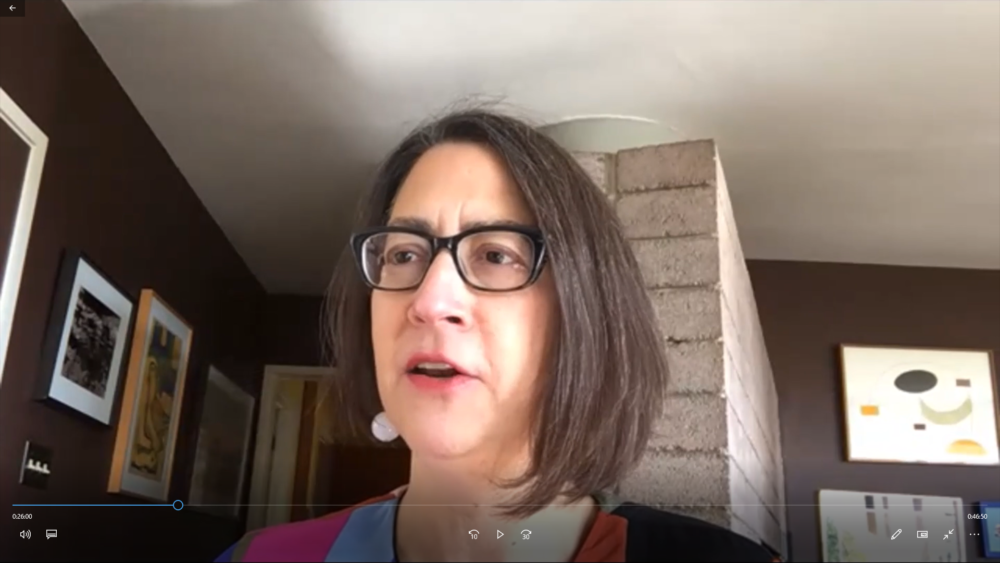
Assembly Member Friedman
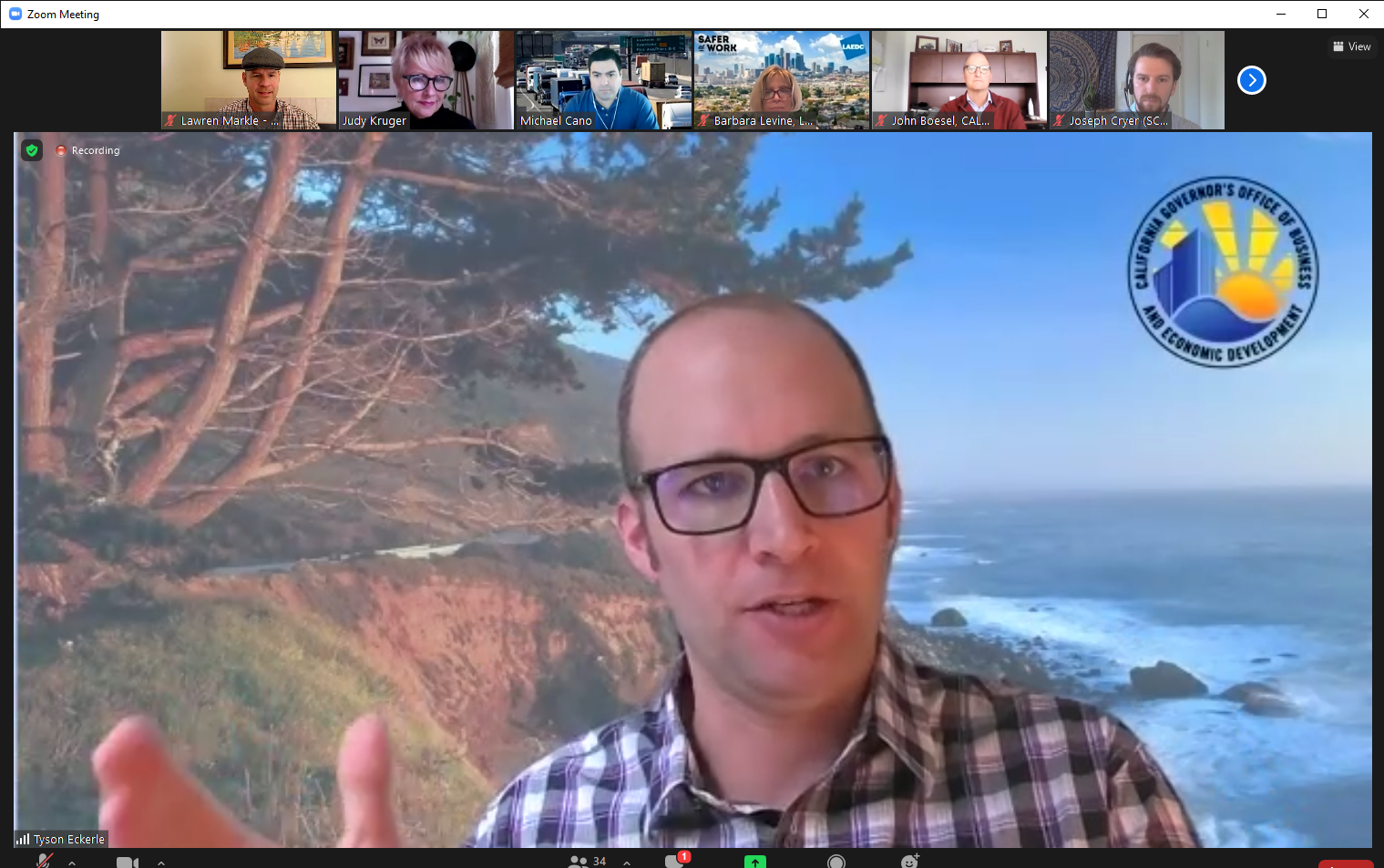
Tyson Eckerle
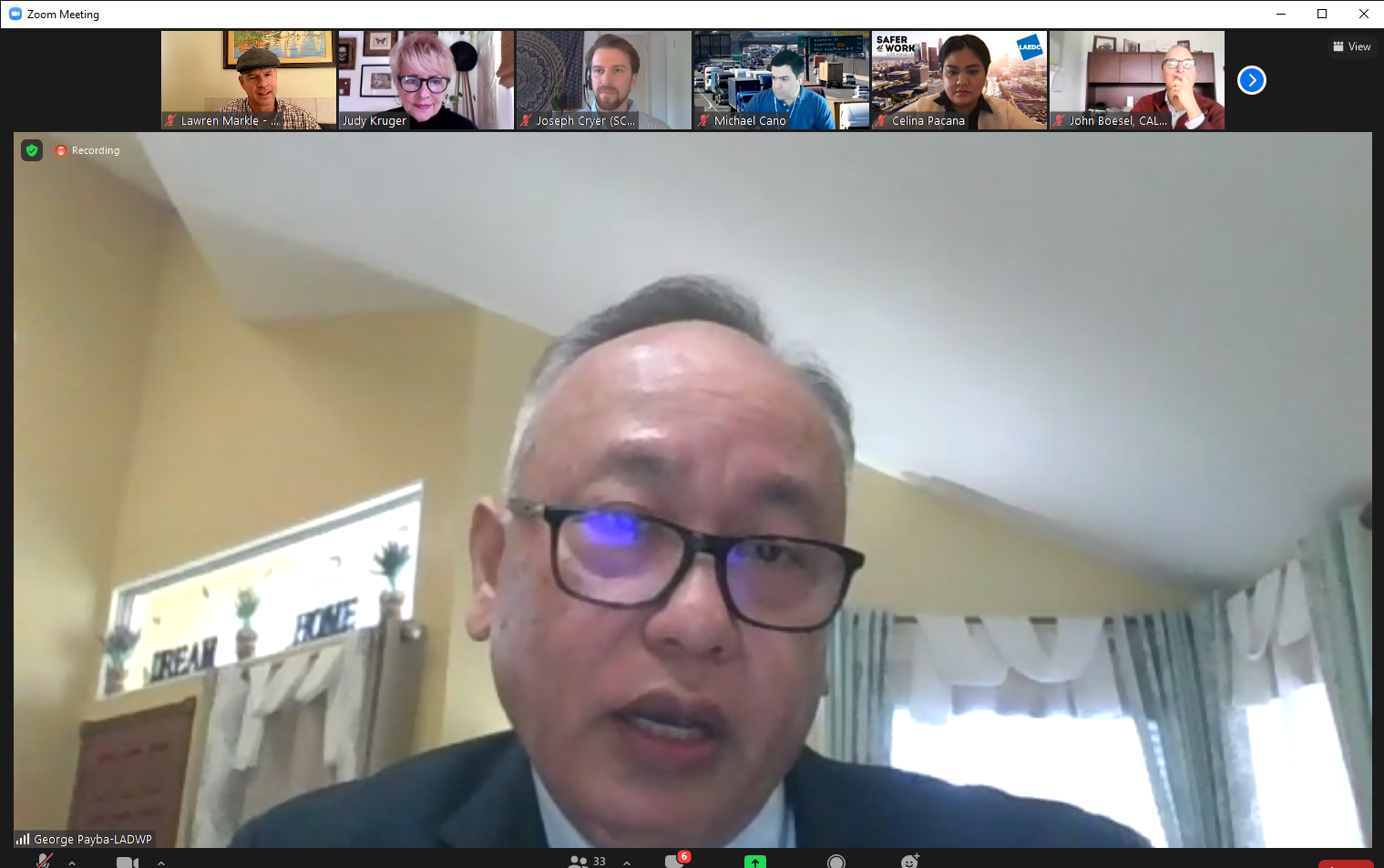
George Payba
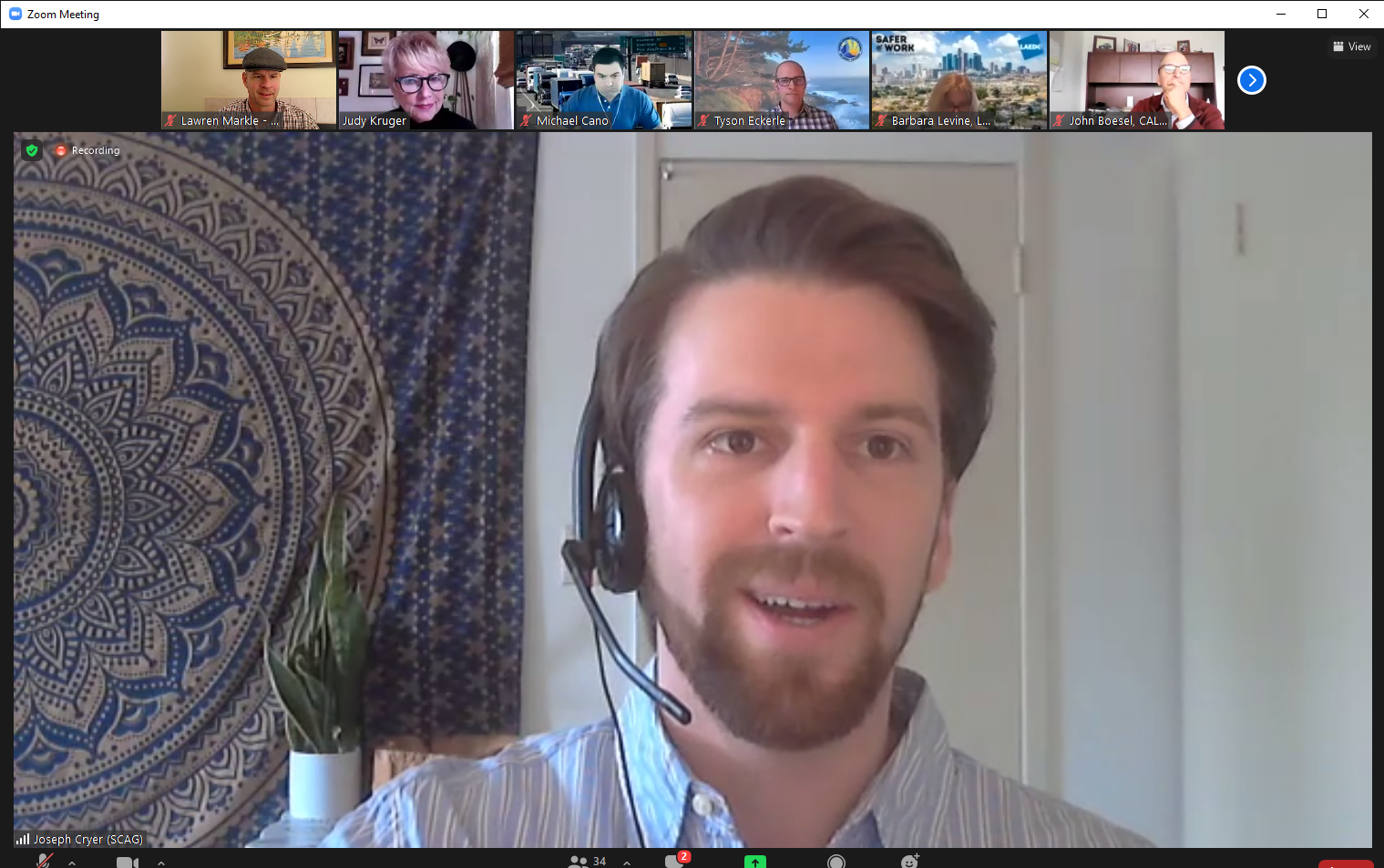
Joseph Cryer
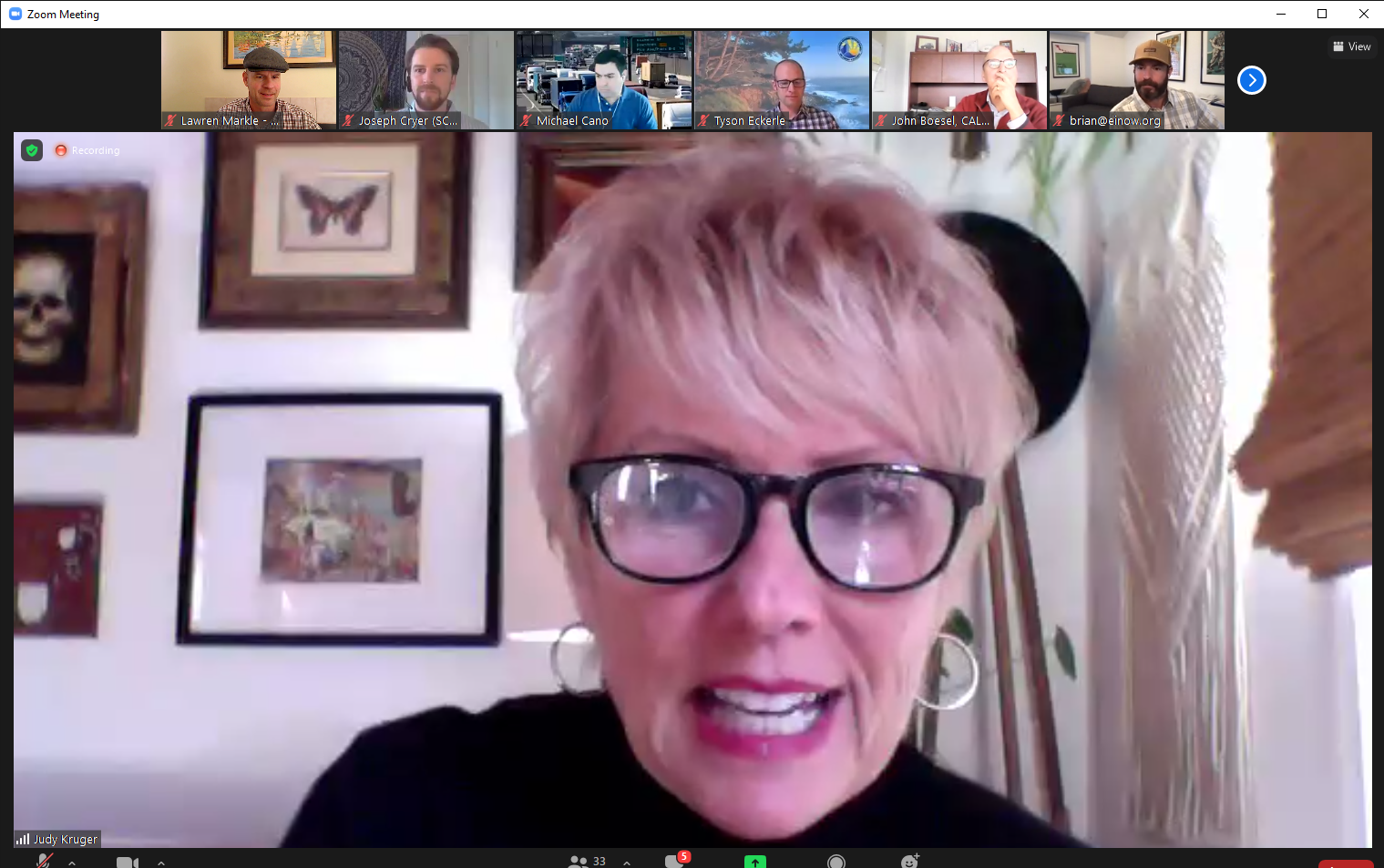
Judy Kruger
Assemblywoman Laura Friedman: Transportation is connected to housing, land use, quality of life. We have to reduce GHGs and other pollutants, but in addition to ZEVs we also need more public transit and fewer miles driven. So ZEVs are a big part of this, but not the only solution. She believes the governor’s goal of 100% ZEV passenger vehicles by 2035 is do-able. She sees it may be a more difficult road to the medium and heavy duty trucks ZEV goals, and said there are discussions about whether the stronger strategy is to bridge with cleaner fuel now and then move to ZEVs later, or whether the stronger case is for moving directly to ZEVs, “this is a conversation we need to have.” The state has done a lot to address climate and sustainability, but transportation has been a more difficult challenge and in many ways we’ve gone the wrong direction. We want to be a model for the rest of the nation and the world, by being aspirational with our policies, our funding and everything we do. She also discussed the need for flexibility across the different types of community because what works in a rural farm community is different than what works in the urban centers. She discussed the inefficient land use for parking and “single-vehicle types of problems” that make communities less walkable and bikeable. We are not going to achieve these goals without investment from the state, and the new budget shows that investment. Now we need to make sure the infrastructure is there to support the transition and ensure purchasing incentives are more useful to residents and make a difference in their ability to buy them.
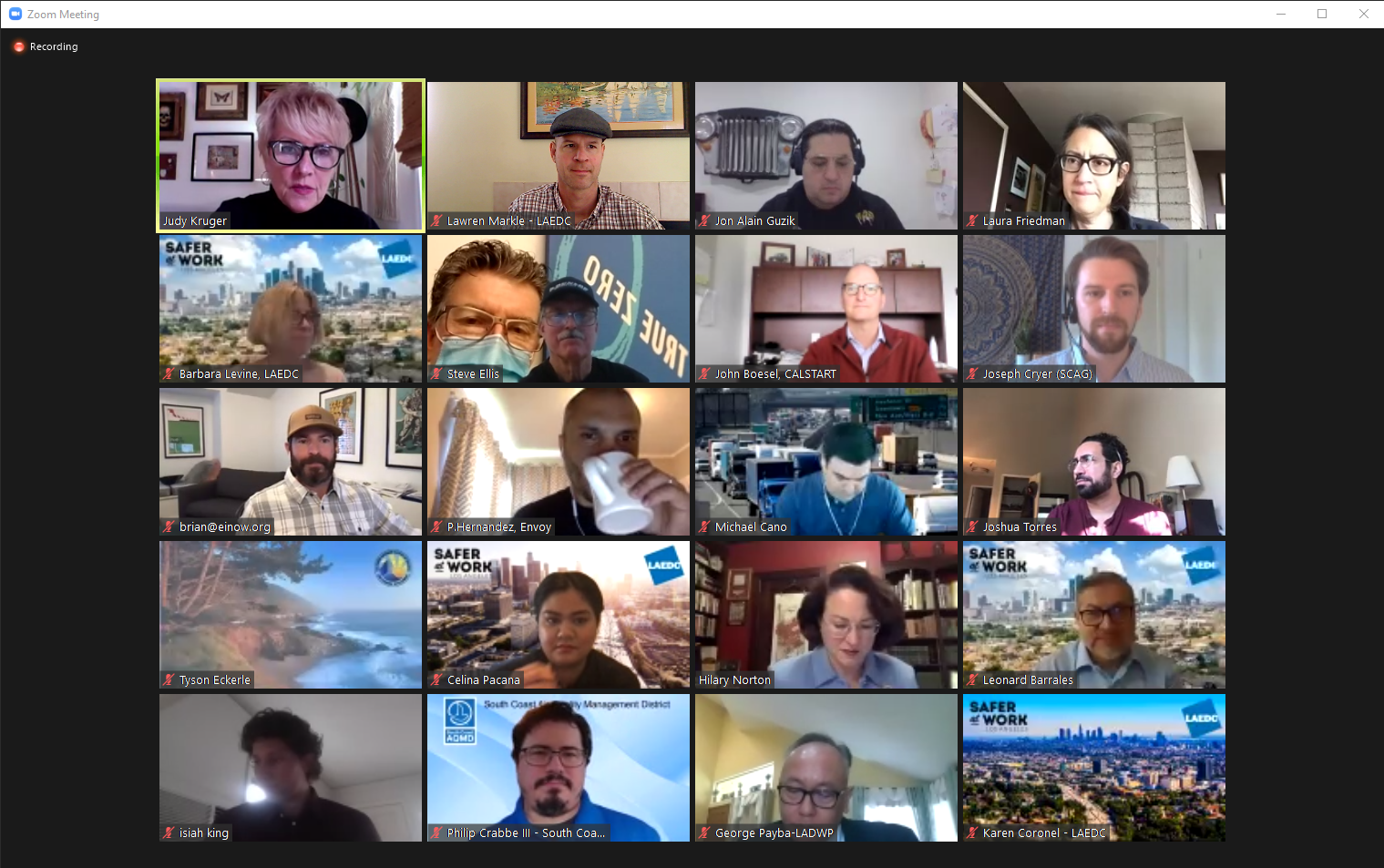 She said she will continue to push for as much EV infrastructure funding as possible to increase confidence among consumers that charging is readily available, but also noted there are a lot of priorities in the state, including healthcare, wildfire risk reduction programs and more… And she applauded the federal priorities that might help with funding to increase light rail and other job-creating job stimulus to reduce reliance on cars. She sees this as a chance to increase mobility equity.
She said she will continue to push for as much EV infrastructure funding as possible to increase confidence among consumers that charging is readily available, but also noted there are a lot of priorities in the state, including healthcare, wildfire risk reduction programs and more… And she applauded the federal priorities that might help with funding to increase light rail and other job-creating job stimulus to reduce reliance on cars. She sees this as a chance to increase mobility equity.
She said communities that have shouldered the burden of pollution are also lacking walkable, bikeable routes and I’d like to see a lot of funding go into these low-income communities as a priority. Every dollar we put into climate priorities also has a direct positive impact on air quality issues, especially in communities that have experienced too much pollution.
ZEVs are only a piece of the puzzle… we need to figure out how to increase public transit ridership after COVID. If we want a system where most essentials are within a 20-minute walk or bike ride, there is a lot to think about as we try to match our climate goals to the way we live. Changing the way we live and what we allow to be built around us is an important issue.
She posed several questions about infrastructure: Are low income communities going to be late adopters and so will charging stations be stranded assets if they aren’t being used? Are alternatives like bus-only lanes a good strategy? We also need to think about the autonomous vehicle future, and how it changes our infrastructure rollout… If these cars can go charge somewhere on their own, do we need chargers in our garages?
Hilary Norton, Chair of California Transportation Commission, thanked LAEDC for hosting this panel, because we need to focus on what the future looks like and how we will achieve the future together. It is so important that we at CTC and Caltrans and CARB and CEC and Go-BIZ and Smart Growth Council and housing development organizations are working together in ways we haven’t before, meeting quarterly to collaborate on how these pieces fit together. At CTC we are using SB 1 funds to make roadways and active transportation work with the ZEV investments coming. Last year we identified $22 billion in projects for funding, that will equal 350,000 jobs. Our ask of the federal government for EV mobility funding is stronger because we leverage increased sales tax revenues that can go towards operations budgets for public transit and EV transit. We’ve been funding things like managed lanes, which has been a direct funding source for better buses. For example, the Silver Line is going all EV. We have a new EV bus system planned for Burbank-Eagle Rock-Glendale. We are also studying how we move from the gas tax to something else so that we can continue to fund EV infrastructure. “California is America’s pilot project,” so getting this right is important.
CTC will be talking to the federal government about supporting truck-only lanes and truck pull-off lanes for charging. Charging infrastructure along a truck route is a very important addition to our ZEV strategy and those funds will be essential.
High density and equitable development supported by high quality transit are big keys. We need to reduce single occupancy driving 75% by 2035. At UCLA, she is also working on connecting EV bus, EV micro-transit, EV rail, EV streetcars and active transportation to support high density equitable development with high quality transit.
To help increase use of EVs, we need to look at:
- Managed lanes which incentivize EV purchases. Giving roadway networks a value and allowing EV vehicles to reduce their payment to use these lanes will continue to be a big incentive. The data shows that 75% of drivers who bought EVs cited use of these lanes as a factor in their decision.
- We are going to be doing equity listening sessions at CTC, to help us focus investments, so those neighborhoods with air quality issues are the first to get investment.
As part of our overall EV strategy, we absolutely need to grow the grid, and look at grid resiliency. The Biden administration is supporting increases in capacity, to make sure we have grid security and enhancement. We also need to invest in technology so that low-income neighborhoods can install charging with solar, which will be a great job creator, which will reduce utility costs, and reduce the need to completely rewire a house which is expensive. This is the year to get things done, and CTC wants to be your partner to proliferate ZEVs and run them on the best roads we can offer.
Tyson Eckerle Dep. Director, ZEV Market Development, GO-BIZ: Tyson said these discussions are so valuable. He said Newsom’s ZEV targets are bold – this won’t be easy, there’s a lot of work ahead of us and GO-BIZ is developing a market strategy, which will go along with smart policy and investment. The ZEV strategy (LINK) and budget go together. Scale and equity are key. We are trying to shift funding to financing, to bridge the gap between grants and private capital. Our catalyst fund will bring down the cost of private financing for these investments. The Clean Cars for All program is a factor, and we also need to focus on the big vehicles that have a big impact on communities.
Our ZEV strategy is a bet on people – let’s think of living in 2045, where the air is clean, clean energy jobs are abundant. How did we get here? Policy and targets need to be implemented collaboratively… We know the vehicle mile reduction strategy is a part of this.
There are four pillars to our ZEV strategy: Equity in every decision, Embracing all ZEV pathways, Collective problem solving (e.g. public action supports private action), and Designing for resilience and adaptation. We look at vehicles, infrastructure, end-users, and workforce. Our strategy is 100 pages but the first 20 pages lay out the objectives for all agency and stakeholder groups to connect this work. We will also be measuring metrics.
There are 28 agencies with their hands in this! So we have tried to simplify that in our strategy. We identify tactics under each objective, like interconnection, permitting, etc. We’re working together to end the need for internal combustion. Sign up for our mailing list and read the first 20 pages on the ZEV strategy.
Judy Kruger: Discussed the LAEDC EV report with great content on policy, jobs, industry growth. Our focus on the various forms of equity, environmental equity, transportation equity – this planning and the policy behind it is critical and it’s great to see everyone thinking about this.
THE MEETING SPLIT INTO THREE BREAKOUT SESSIONS
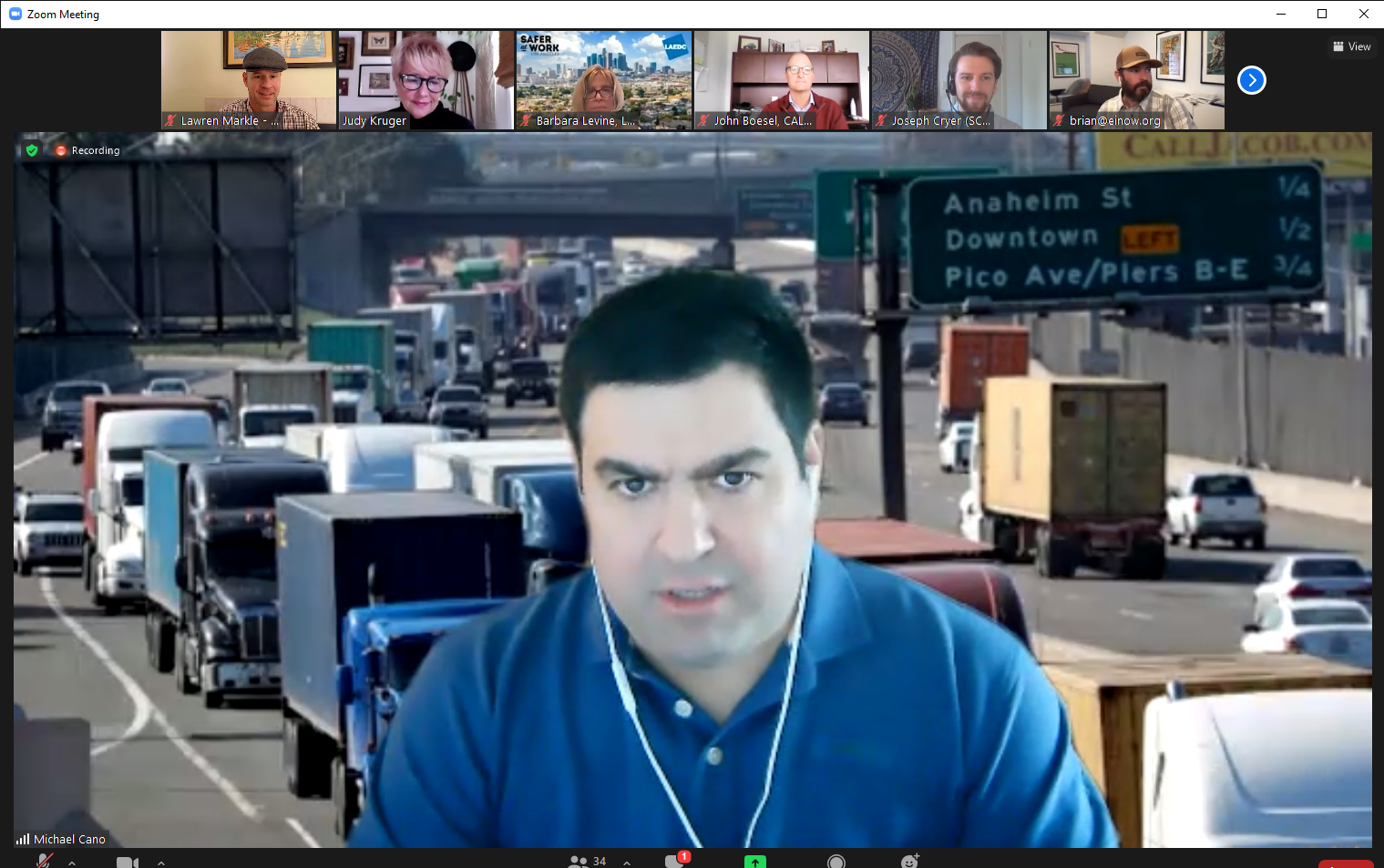
Michael Cano, Deputy Executive Officer, LA Metro led the breakout on scaling charging infrastructure with more widespread use:
- Trucks are a big piece of this. There was discussion of hydrogen’s role, for example Metrolink in San Diego County is piloting hydrogen trains. Hydrogen makes sense for large cargo vehicles because batteries can be 10% of the cargo for big freight loads, that’s a lot. And hydrogen allows quicker refueling. The opinion was expressed that over 50% of the ZEV mix may be hydrogen. Fuel cells are a mature technology and fueling stations are a mature technology. Hydrogen infrastructure for buses is dramatically lower than EV charging infrastructure for buses, so that needs to be explored. The costs associated with electric charging can be daunting
- Fast charging stations can be located more conveniently, for safe, easy access to increase use. Fast charging stations are often in poor locations, such as fourth floor of a shopping center garage which isn’t optimal or safe. LA Metro is looking at charging stations in more convenient locations, like on properties that operate fleets. Convenient locations, especially for trucks, to avoid leaving the freeway for 15 minutes is important. A partnership with the utilities is essential for siting fast DC chargers, to determine where the power is available for these high amperage stations.
- AB841 passed allows a tariff that will help open the door for the utility to fund adequate power for charging stations. That will begin shortly with the utilities.
- Discussed the cities along the 710 corridor to place charging stations: Caltrans is a factor, if they have property along the freeway… then it’s a public-public relationship which can be faster, easier to plan. The cleantech program using state funding says no CNG fueling stations in the communities. The point is they don’t want CNG trucks rumbling into neighborhoods to fuel. This is an aspect of social equity.
- Demand management can be improved if we get all these smart meters and smart appliances -especially residential charging – talking to each other. We are working on a bill (Friedman) to help the implementation to more effectively manage timing of demand. Demand mgmt. and peaking and load management will be mor essential as we add EV charging. So the CEC can drive progress on this. Assemblymember Friedman is writing the bill now, and would like to hear from stakeholders! Jim in her Sacramento office is the contact.
- Prioritizing daytime charging such as workplace charging will be beneficial because charging will take place during peak solar production and ease the problems associated with peak load from 4-9pm.
Joseph Cryer, Associate Regional Planner, SCAG led a breakout on multifamily:
- Big topic was old buildings versus new. New building are much easier, helps as a marketing tool. Old buildings will require incentives based on higher costs. Charging at home and public stations are both needed.
- If we locate charging in strip malls and business locations, local small businesses will be supported by consumers while they charge.
- Talked about solar carports to help manage load and get these systems deployed.
- Reduced rates for electricity for charging at residential would help adoptions and infrastructure.
- More shared vehicles as a key piece too.
- Workforce development and education to educate permitting technicians as well as contractors to put the infrastructure in the ground.
George Payba, Director, Electrification of Transportation Systems and EV Policy at LADWP led the breakout on how to increase adoption of EVs in low-income communities:
- We should be flexible, different communities need different ideas
- Curbside charging, light pole charging
- Shared mobility like Blue LA
- Look into and support not just vehicles but e-bikes, e-scooters to incentive their use for shorter trips.
- Education and outreach to communities about rebates, lower operating costs of EVs. Rebates are confusing and they are available from various sources, and we need a one-stop rebate website that can do all the applications for you to reduce confusion.
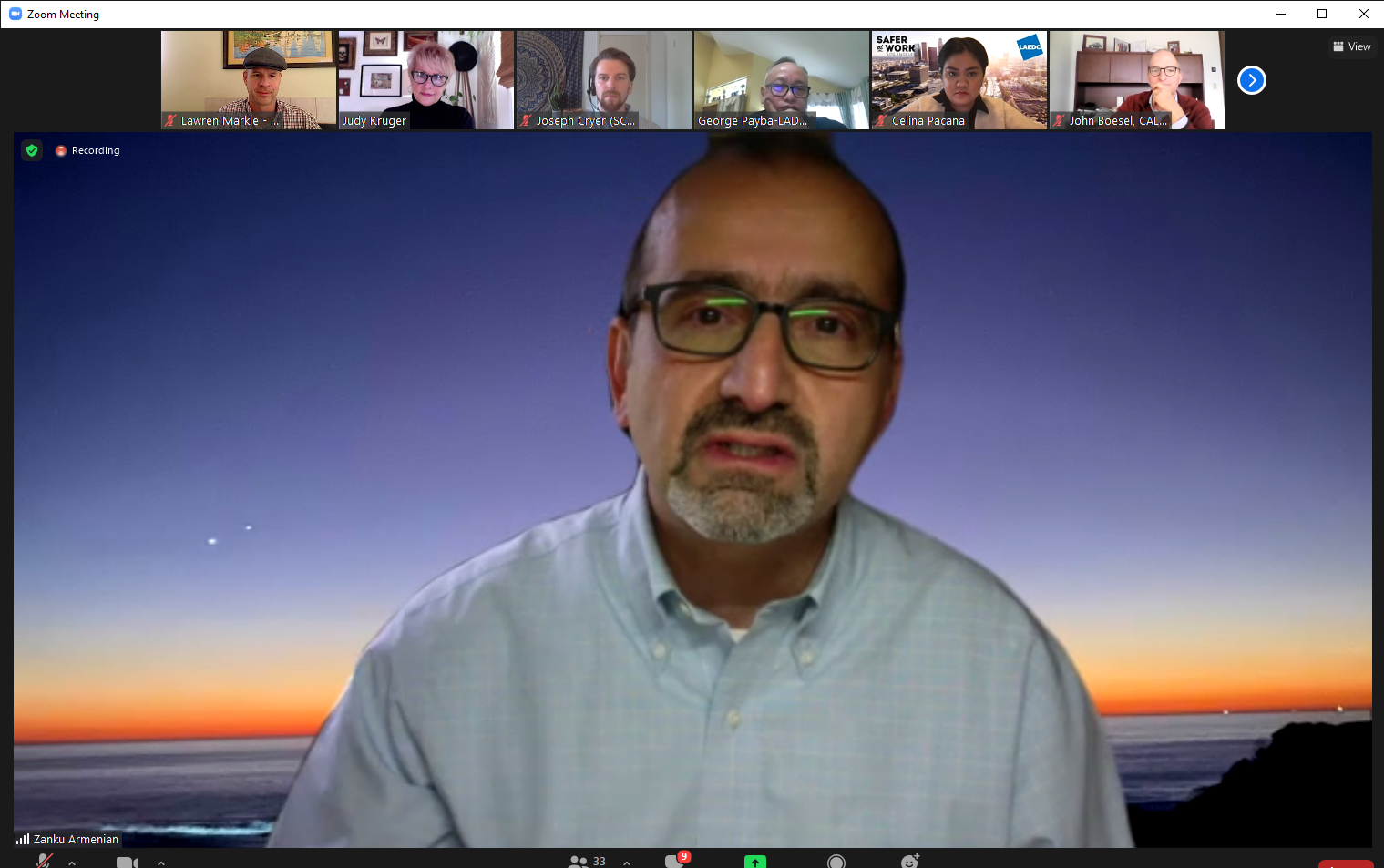 Closing speaker Zanku Armenian, Director of Public Affairs for SCE said Edison is about halfway to 100% renewable utility power generation! He is happy that we could all join to discuss these issues, and thanked electeds for participation. We need to make it easy to charge, at home, workplaces, multifamily, etc. Adding charging to existing mutlifamily will be difficult and important. SCE is continuing to add stations with the ChargeReady 2 program, which is launching in Q3 this year, to install about 38,000 charging ports…. With an extraordinary focus on equity – about half of the stations will be installed in communities most impacted by emissions. Medium and heavy vehicles are the largest source of emissions, so we have programs for those as well, such as along the 710 corridor; those neighborhoods are impacted and a big focus for us. This transition to EVs will be an economic success, creating jobs. LAEDC’s EV report found that EV industry in SoCal already employs over 100,000 workers with avg salary over $80,000. Energy management and construction are sectors that will benefit from jobs, and are essential partners in this transition. With Biden, we now have a willing partner, allowing California to set its own tailpipe standards, for example. Newsom’s budget of $1.5 billion to support purchases of EVs and charging installation is also great. Work remains… We need to be aware that some people would like to delay this transition, so we need closer collaboration to have more coordinated advocacy in this transformative year. Thanks again to Assemblymember Laura Friedman for taking a lead role in this effort. Please consider SCE as a willing partner in these discussions and we hope to lean in together on these challenges; we have federal state and local initiatives to support fast progress.
Closing speaker Zanku Armenian, Director of Public Affairs for SCE said Edison is about halfway to 100% renewable utility power generation! He is happy that we could all join to discuss these issues, and thanked electeds for participation. We need to make it easy to charge, at home, workplaces, multifamily, etc. Adding charging to existing mutlifamily will be difficult and important. SCE is continuing to add stations with the ChargeReady 2 program, which is launching in Q3 this year, to install about 38,000 charging ports…. With an extraordinary focus on equity – about half of the stations will be installed in communities most impacted by emissions. Medium and heavy vehicles are the largest source of emissions, so we have programs for those as well, such as along the 710 corridor; those neighborhoods are impacted and a big focus for us. This transition to EVs will be an economic success, creating jobs. LAEDC’s EV report found that EV industry in SoCal already employs over 100,000 workers with avg salary over $80,000. Energy management and construction are sectors that will benefit from jobs, and are essential partners in this transition. With Biden, we now have a willing partner, allowing California to set its own tailpipe standards, for example. Newsom’s budget of $1.5 billion to support purchases of EVs and charging installation is also great. Work remains… We need to be aware that some people would like to delay this transition, so we need closer collaboration to have more coordinated advocacy in this transformative year. Thanks again to Assemblymember Laura Friedman for taking a lead role in this effort. Please consider SCE as a willing partner in these discussions and we hope to lean in together on these challenges; we have federal state and local initiatives to support fast progress.
LAEDC thanks sponsor Southern California Edison, a great partner and long-time LAEDC member.
If you are interested in connecting with LAEDC’s e4 Mobility Alliance, contact Celina Pacana at LAEDC, [email protected]